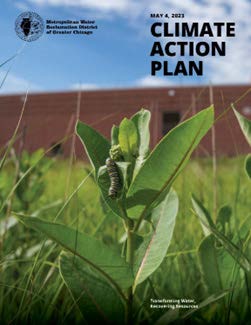A plan to address climate change: MWRD outlines strategy to lower its carbon footprint and recommit to protecting water
News & Events | May 31st, 2023

The critical agency tasked with protecting the Chicago area’s water environment and managing the effects of climate change on water, has now adopted a plan to reduce its own greenhouse gas emissions to thwart the devastating effects of global warming, flooding and pollution that threaten the region’s water resources.
The Board of Commissioners at the Metropolitan Water Reclamation District of Greater Chicago (MWRD) formally adopted a climate action plan (CAP) that has been carefully scrutinized for more than four years. Part of this assessment included the commissioning of an interdepartmental task force, a public comment period, and staff and commissioner interaction, review and feedback. To read the MWRD’s CAP and learn more about the MWRD’s efforts to lower its carbon footprint, visit mwrd.org/climateaction.
“We are proud to put our Climate Action Plan in motion to serve as a roadmap to help reduce our carbon footprint and take climate action to protect our planet for future generations,” said MWRD President Kari K. Steele. “Having a robust climate action plan will prepare us to confront another chapter of adversity in our 134 years of service to protect Chicago area residents and their water.”
Following the adoption of the MWRD’s Strategic Plan 2021-2025 the CAP is another comprehensive document presenting an even longer-term vision to help steer the MWRD well into the 21st century. The CAP is also a living document intended for revision within a year of Strategic Plan updates to measure the status of MWRD goals and work in meeting ambitious benchmarks.
Setting 2005 as a baseline in greenhouse gas emission reporting, the MWRD has set milestones of a 28 percent reduction by 2025 and an 80 percent reduction by 2050 compared to 2005 levels, with additional stretch targets of 50 percent reduction by 2025 and achieving net-zero by 2050. The CAP outlines how the MWRD will meet these targets. To read the CAP, visit mwrd.org.
“New technology, accountability and understanding has given us a century-long viewpoint into the effects of climate change and how we plan to address it,” said MWRD Commissioner and Chairman of Finance Marcelino Garcia. “This ambitious plan will inspire us to make bold decisions to protect our planet while also ensuring that our essential services are here to protect our water environment and the public’s health.”
Using a four-tiered structure as a pathway to meet its climate goals, the CAP will inform future infrastructure planning, support climate resiliency infrastructure investment decisions, guide mitigation of the MWRD’s greenhouse gas emissions and inform the public of the MWRD’s plans to address climate change.
Studies have shown that climate change warms the atmosphere and alters the hydrological cycle to cause extreme weather events and impact the amount, timing, form and intensity of precipitation. This unpredictable stormwater flow will affect the instrumental work of water and wastewater utilities like the MWRD.
Each day, the MWRD collects and transforms the region’s wastewater, urban runoff and stormwater into clean water and releases it back into the environment to serve and protect 5.19 million residents living in Chicago and 128 surrounding suburbs. In 2022, the MWRD treated more than 430 billion gallons of water at its seven innovative water reclamation plants. Between its seven facilities, the MWRD has the potential to process and treat more than 2 billion gallons of water per day.
Since 2004, the MWRD has served as the regional authority for stormwater management in Cook County. Partnering with local municipalities, environmental organizations, water stewards and government entities, the MWRD has developed more than 200 stormwater projects that have the potential to protect more than 17,000 structures. In addition, the MWRD controls 76 miles of navigable waterways, owns and operates 33 stormwater detention reservoirs, and 560 miles of intercepting sewers. The MWRD’s Tunnel and Reservoir Plan (TARP) also includes 110 miles of deep tunnel and three massive reservoirs that provide billions of gallons of storage capacity to serve combined sewer systems throughout the Chicago area and protect waterways from untreated water and basements and streets from flooding.

